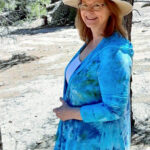As promising as the weather prognostications materialized for the gradual relief of summertime heat over the holiday weekend — happily enough for the various yard sale promoters — the prospects for the annual Levy and Speltz families’ benefit for the Idyllwild Arts Foundation were even greater, due not only to a better event venue, just off of South Circle Drive with ample parking spaces, but also to the presence of top-quality performers.
Both players and audience were seated comfortably in an enlarged patio area and in a somewhat sheltered grassy arena guarded by tall cedars and pines. The proceedings started with a more or less natural invocation provided by Lisa Edelstein’s clear rendition of Claude Debussy’s solo flute piece “Syrinx.” The music floated over the audience members somewhat antiphonally (chiefly from the rear to the front), thus providing a calming influence over the scene and mitigating the eventual cloudburst with a moistening effect of its own.
With the segue to the middle movements of Beethoven’s String Trio (Opus 9 No. 2), the concert proceeded in full swing with the audience in full anticipatory mode of a downpour following a most Beethovenian peal of thunder between the movements. As it turned out, both auditors and players were relatively unaffected by the one-hour elemental display (with only enough precipitation to dampen the ground for another hour or so), and applauded those first selections approvingly.
Things proceeded with a little-performed work from the early 1950s of Heitor Villa-Lobos for flute and cello, “Assobio a Jato” (The Jet Whistle). Edelstein’s technique displayed brilliantly throughout the light to moderate rainfall, particularly in the frenzied last movement, where the flutist is called upon to execute rapid glissandos covering the instrument’s full range. It seemed to this listener that Villa-Lobos was incorporating the sounds of the Brazilian rainforest and jet-engine takeoffs into the piece, perhaps as an advance warning of the detrimental impact of the latter upon the former.
Continuing in somewhat diversionary fashion, the Larghetto movement from Dvorak’s Terzetto (Opus 74) — originally for two violins and viola — was made somewhat sweeter by the substitution of Edelstein’s flute for the first violin part and further assuaged the surroundings. The effect on both listeners and the environs was that of overall calm, and a restfulness afforded only by attention to the details brought to the fore in this arrangement.
Following that, American composer Mark O’Connor’s 1992 composition “F. C.’s Jig” (for violin and cello) was a short excursion into the contemporary, and the dilemma of reconciling Irish-based fiddle music and then-current minimalism was solved. In the sprightly figurations of the violin and the bouncing cello part, both Connie Kupka (violin) and David Speltz (cello) were totally vindicated in due time. The culmination of the proceedings proved to be Mozart’s C Major Flute Quartet (K. 285b), whose two movements provided the requisite calm again, and with the surprisingly swift coda to the final variation, all four players were heartily applauded. Speltz had an alternative ending in the works.
The noteworthy jazz guitarist Bruce Forman was introduced and made his way to the stage for a performance of three short numbers. The first was an improvisation. The second was a song concerning fading memories and recurring attempts at retrieval, and the third was an exegetical exposure of American blues players and singers.
What had begun in silent evocation ended in a free fantasy, with both participants and audience members left to partake of appetizers and pastries, and good wishes for the Idyllwild Arts Foundation.










